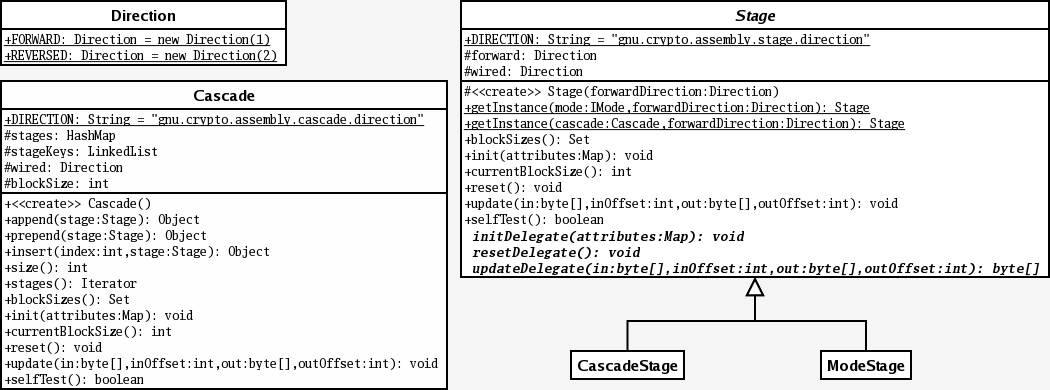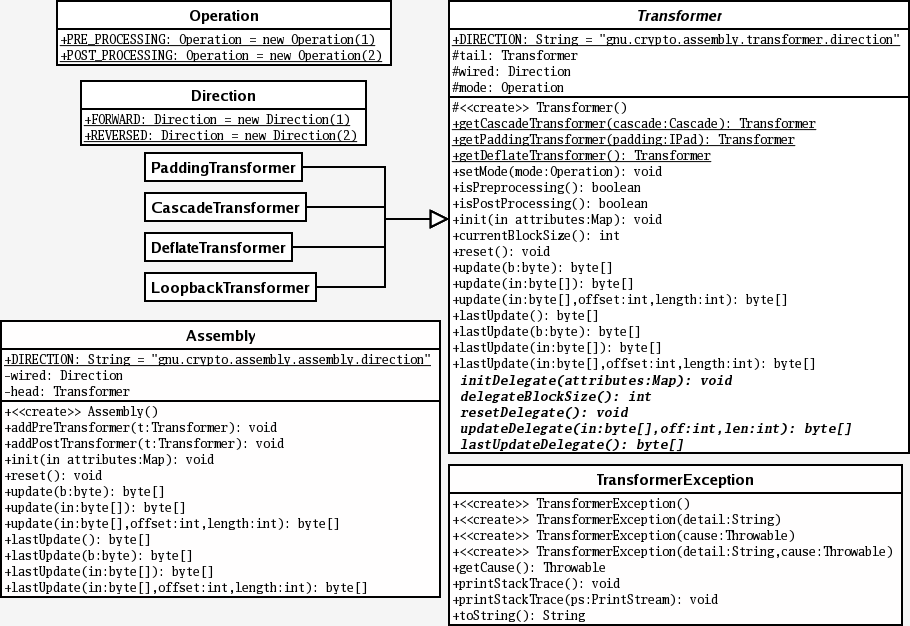
|
For the latest news and information visit The GNU Crypto project |
||||||||||
| PREV PACKAGE NEXT PACKAGE | FRAMES NO FRAMES | ||||||||||
See:
Description
| Class Summary | |
| Assembly | An Assembly is a construction consisting of a chain of
Transformer elements; each wired in pre- or post- transformation
mode. |
| Cascade | A Cascade Cipher is the concatenation of two or more block ciphers each with independent keys. |
| CascadeStage | A Cascade Stage in a Cascade Cipher. |
| CascadeTransformer | An Adapter to use any Cascade as a Transformer in an
Assembly. |
| DeflateTransformer | A Transformer Adapter allowing inclusion of a DEFLATE compression
algorithm in an Assembly chain. |
| Direction | An enumeration type for wiring Stage instances into Cascade Cipher chains, as well as for operating a Cascade in a
given direction. |
| LoopbackTransformer | A trivial Transformer to allow closing a chain in an Assembly.
|
| ModeStage | An IMode Stage in a Cascade Cipher chain. |
| Operation | An enumeration type for specifying the operation type of a
Transformer. |
| PaddingTransformer | An Adapter to use any IPad as a Transformer in an
Assembly. |
| Stage | A Stage in a Cascade Cipher. |
| Transformer | A Transformer is an abstract representation of a two-way
transformation that can be chained together with other instances of
this type. |
| Exception Summary | |
| TransformerException | |
Provides a high-level API for combining and using GNU Crypto cipher, mode, and padding primitives.
This package describes two patterns implemneted by the GNU Crypto library that allow users to combine the basic cipher (and other) primitives into higher level components in order to offer more flexible functionalities. These two patterns are: Cascade and Assembly.
The Cascade is a means of assembling block cipher Modes of Operations into an ordered sequence of stages. A stage is a representation of a Mode (of Operations) wired in a designated direction: FORWARD or REVERSED. A Mode staged in the FORWARD direction would encrypt input blocks, producing ciphertext, while the same Mode, wired in the REVERSED direction would do the opposite; i.e. decrypt an input text producing a plaintext.
In the simplest case, all stages in a Cascade have k-bit keys, and the stage inputs and outputs are all n-bit quantities. The stage ciphers may differ (general cascade of ciphers), or all be identical (cascade of identical ciphers).
An Assembly is a construction of an ordered set of Transformer objects. Each Transformer is wired to operate in PRE_PROCESSING or POST_PROCESSING mode --the Transformer's operation. In PRE_PROCESSING, the input is first processed by the Transformer before being passed to the rest of the chain, while in POST_PROCESSING state, the Transformer first passes the input to the rest of the chain and only processes the output of the returned data.
The following diagram shows the important classes participating in the Cascade pattern:

Here is an example of how a Cascade is used to construct a DES-EDE symetric-key block cipher from three independent DES cipher instances:
HashMap map = new HashMap();
HashMap map1 = new HashMap();
HashMap map2 = new HashMap();
HashMap map3 = new HashMap();
Cascade new3DES = new Cascade();
Object des1 = new3DES.append(
Stage.getInstance(
ModeFactory.getInstance(Registry.ECB_MODE, new DES(), 8),
Direction.FORWARD));
Object des2 = new3DES.append(
Stage.getInstance(
ModeFactory.getInstance(Registry.ECB_MODE, new DES(), 8),
Direction.REVERSED));
Object des3 = new3DES.append(
Stage.getInstance(
ModeFactory.getInstance(Registry.ECB_MODE, new DES(), 8),
Direction.FORWARD));
map.put(des1, map1);
map.put(des2, map2);
map.put(des3, map3);
map1.put(IBlockCipher.KEY_MATERIAL, key1material);
map2.put(IBlockCipher.KEY_MATERIAL, key2material);
map3.put(IBlockCipher.KEY_MATERIAL, key3material);
// encryption
map.put(Cascade.DIRECTION, Direction.FORWARD);
byte[] pt = ...; // some plaintext to encrypt
byte[] ct = new byte[pt.length]; // where ciphertext is returned
try
{
new3DES.init(map);
new3DES.update(pt, 0, ct, 0);
}
catch (InvalidKeyException x)
{
x.printStackTrace(System.err);
}
The following diagram shows the important classes participating in the Assembly pattern:

Here is an example of how to compress and encrypt a stream of plaintext:
import gnu.crypto.Registry;
import gnu.crypto.util.Util;
import gnu.crypto.assembly.Assembly;
import gnu.crypto.assembly.Cascade;
import gnu.crypto.assembly.Direction;
import gnu.crypto.assembly.Stage;
import gnu.crypto.assembly.Transformer;
import gnu.crypto.assembly.TransformerException;
import gnu.crypto.cipher.Blowfish;
import gnu.crypto.cipher.IBlockCipher;
import gnu.crypto.mode.IMode;
import gnu.crypto.mode.ModeFactory;
import gnu.crypto.pad.IPad;
import gnu.crypto.pad.PadFactory;
HashMap attributes = new HashMap();
HashMap modeAttributes = new HashMap();
Cascade ofbBlowfish = new Cascade();
Object modeNdx = ofbBlowfish.append(
Stage.getInstance(
ModeFactory.getInstance(Registry.OFB_MODE, new Blowfish(), 8),
Direction.FORWARD));
attributes.put(modeNdx, modeAttributes);
IPad pkcs7 = PadFactory.getInstance(Registry.PKCS7_PAD);
Assembly asm = new Assembly();
asm.addPreTransformer(Transformer.getCascadeTransformer(ofbBlowfish));
asm.addPreTransformer(Transformer.getPaddingTransformer(pkcs7));
asm.addPreTransformer(Transformer.getDeflateTransformer());
// plaintext and key material
byte[] km = new byte[] { 0, 1, 2, 3, 4, 5, 6, 7, 8};
byte[] iv = new byte[] {-1, -2, -3, -4, -5, -6, -7, -8, -9};
byte[] pt = new byte[] { 0, 1, 2, 3, 4, 5, 6, 7, 8, 9, 10, 11};
byte[] tpt = new byte[11 * pt.length];
// forward transformation
modeAttributes.put(IBlockCipher.KEY_MATERIAL, km);
modeAttributes.put(IMode.IV, iv);
attributes.put(Assembly.DIRECTION, Direction.FORWARD);
try
{
asm.init(attributes);
}
catch (TransformerException x)
{
x.printStackTrace(System.err);
}
byte[] ct = null;
ByteArrayOutputStream baos = new ByteArrayOutputStream();
try
{
for (int i = 0; i < 10; i++)
{ // transform in parts of 12-byte a time
System.arraycopy(pt, 0, tpt, i * pt.length, pt.length);
ct = asm.update(pt);
baos.write(ct, 0, ct.length);
}
}
catch (TransformerException x)
{
x.printStackTrace(System.err);
}
try
{
System.arraycopy(pt, 0, tpt, 10 * pt.length, pt.length);
ct = asm.lastUpdate(pt);
}
catch (TransformerException x)
{
x.printStackTrace(System.err);
}
baos.write(ct, 0, ct.length);
ct = baos.toByteArray();
// reversed transformation
attributes.put(Assembly.DIRECTION, Direction.REVERSED);
try
{
asm.init(attributes);
}
catch (TransformerException x)
{
x.printStackTrace(System.err);
}
byte[] ot = null;
try
{
ot = asm.lastUpdate(ct); // transform the lot in one go
}
catch (TransformerException x)
{
x.printStackTrace(System.err);
}
|
For the latest news and information visit The GNU Crypto project |
||||||||||
| PREV PACKAGE NEXT PACKAGE | FRAMES NO FRAMES | ||||||||||